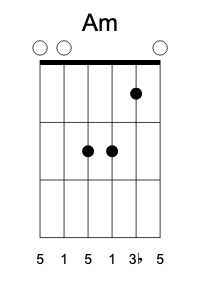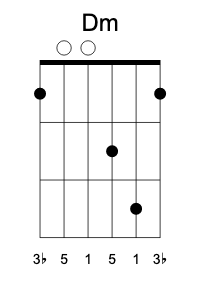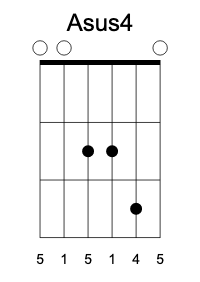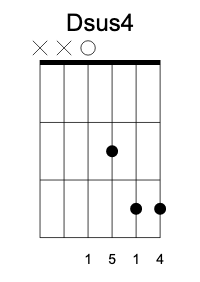So far we’ve been discussing chord transformations that didn’t change the chord’s function. We’ve been essentially dealing with just one major chord and its transpositions. You can think of a major chord as a rigid shape rotating through the circle of pitches: a four-semitone step topped with a three-semitone step, combining to seven semitones of the perfect fifth. We’ll keep the fifth for the time being, because it’s such a nice consonance, but we’ll be mutating the third.
The first such transformation is to lower the third by one step to obtain a minor triad. For some reason, we perceive minor chords as sad or melancholy, sometimes a bit whiny.
They are not very common in pop or rock music, but they are popular in folk and jazz (especially with added sevenths, which makes them edgy).
The first three shapes we’ve seen so far are perfect for this transformation: they have a single third, and it sits under a finger. Lifting or shifting this finger is easy. That changes the major third to a minor third, which we will notate as 3♭, since you can think of it as a flatted third. In jazz, flatting is often represented by a minus sign, so you might see Em notated as E-, and so on.
Here are the three basic minor shapes constructed this way:
When playing Dm, we usually mute the two lowest strings. I also listed the inversion Dm/F, as it’s sometimes used in chord progressions (e.g., a walking bass).
The C shape has the third voiced on an open string, and it’s doubled, so it’s humanly impossible to lower it. G shape is also tricky, although with the “folk” G you could cheat and mute the third, which results in a power chord. A power cord can be substituted, in a pinch, for either a major or a minor chord.
Normally, though, you produce all other minor chords by transposing (barring) either Em or Am.
It’s possible to move the third one more step down, or one step up. This results in suspended chords. Twice lowered third becomes a second, so that chord is called the suspended second. A raised third becomes a fourth, so that chord is called the suspended fourth. They are often used as embellishments, or in progression, with a regular major or minor chord in between (George Harrison’s Something or John Lennon’s Happy Xmas (War Is Over) use this riff extensively).
Suspended fourth works with the E shape as well

But suspended second in E is not very practical, since you have to use the adjacent string at the fourth fret, and you end up with the fifth in triplicate (of course, you can mute one).
Interestingly enough, the second can be reinterpreted as the ninth, an octave over. So, instead of using a suspended second, you may replace it with a better sounding add-nine chord. This one keeps the major third, but adds a ninth:

I’ll let you figure out suspensions for the C and G shapes.
Next: Dominant seventh chords.
from Hacker News https://ift.tt/2XyCHBa










No comments:
Post a Comment
Note: Only a member of this blog may post a comment.